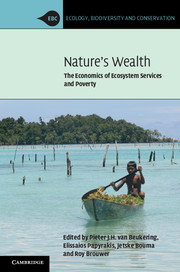Book contents
- Frontmatter
- Contents
- List of contributors
- Acknowledgements
- 1 The economics of ecosystem services and poverty
- Part I Biodiversity-related ecosystem services
- 2 Park–people conflicts, rhino conservation and poverty alleviation in Nepal
- 3 Rural poverty and human–elephant conflicts in Sri Lanka
- 4 Poverty, livelihoods and the conservation of nature in biodiversity hotspots around the world
- Part II Marine-related ecosystem services
- Part III Forest-related ecosystem services
- Part IV Water-related ecosystem services
- Part V Land-related ecosystem services
- Index
- References
2 - Park–people conflicts, rhino conservation and poverty alleviation in Nepal
Published online by Cambridge University Press: 05 July 2013
- Frontmatter
- Contents
- List of contributors
- Acknowledgements
- 1 The economics of ecosystem services and poverty
- Part I Biodiversity-related ecosystem services
- 2 Park–people conflicts, rhino conservation and poverty alleviation in Nepal
- 3 Rural poverty and human–elephant conflicts in Sri Lanka
- 4 Poverty, livelihoods and the conservation of nature in biodiversity hotspots around the world
- Part II Marine-related ecosystem services
- Part III Forest-related ecosystem services
- Part IV Water-related ecosystem services
- Part V Land-related ecosystem services
- Index
- References
Summary
Introduction
The conflict between protected area management and the local use of natural resources from those areas – often termed the ‘park–people conflict’ – has been at the forefront of management and policy debates during the last two decades. However, this conflict goes far beyond the use of natural resources, and as numerous studies have highlighted, includes problems such as ‘human–wildlife conflict’, and the ‘poaching problem’ to name a few. The starting point for most, if not all, of the park–people conflicts seems to be the restriction of the use of resources inside the protected areas, especially of the traditional user rights (Maikhuri et al. 2000, Nepal, 2002). Heinen (1996) argues that most of the conflicts in developing countries which relate to the access and use of resources within protected areas have arisen where countries adopted a Western approach to protected area management. For the most part, this approach prohibits the use and extraction of natural resources inside the protected area. Heinen further points out that any such conflicts in developed countries can be easily resolved due to lower dependence of people on resource extraction. However, it is much harder to resolve these conflicts in countries where users are likely to depend on the protected area resources for their very survival. For instance, people living around the park buffer zone depend on forest products such as food, meat, fruits, medicines, fuels, animal food and building materials for their subsistence. Forests, trees and wildlife are also important components of the natural capital of the poor in the buffer zones of CNP, the central Terai zone of Nepal. Specifically non-farmer and landless households belonging to marginalized ethnic groups, such as Chepang, Bote and Majhi, depend on the forest and aquatic ecosystems for their livelihood. These communities have been living in the forestlands and on the riversides for generations but due to park establishment they were displaced.
- Type
- Chapter
- Information
- Nature's WealthThe Economics of Ecosystem Services and Poverty, pp. 37 - 55Publisher: Cambridge University PressPrint publication year: 2013



